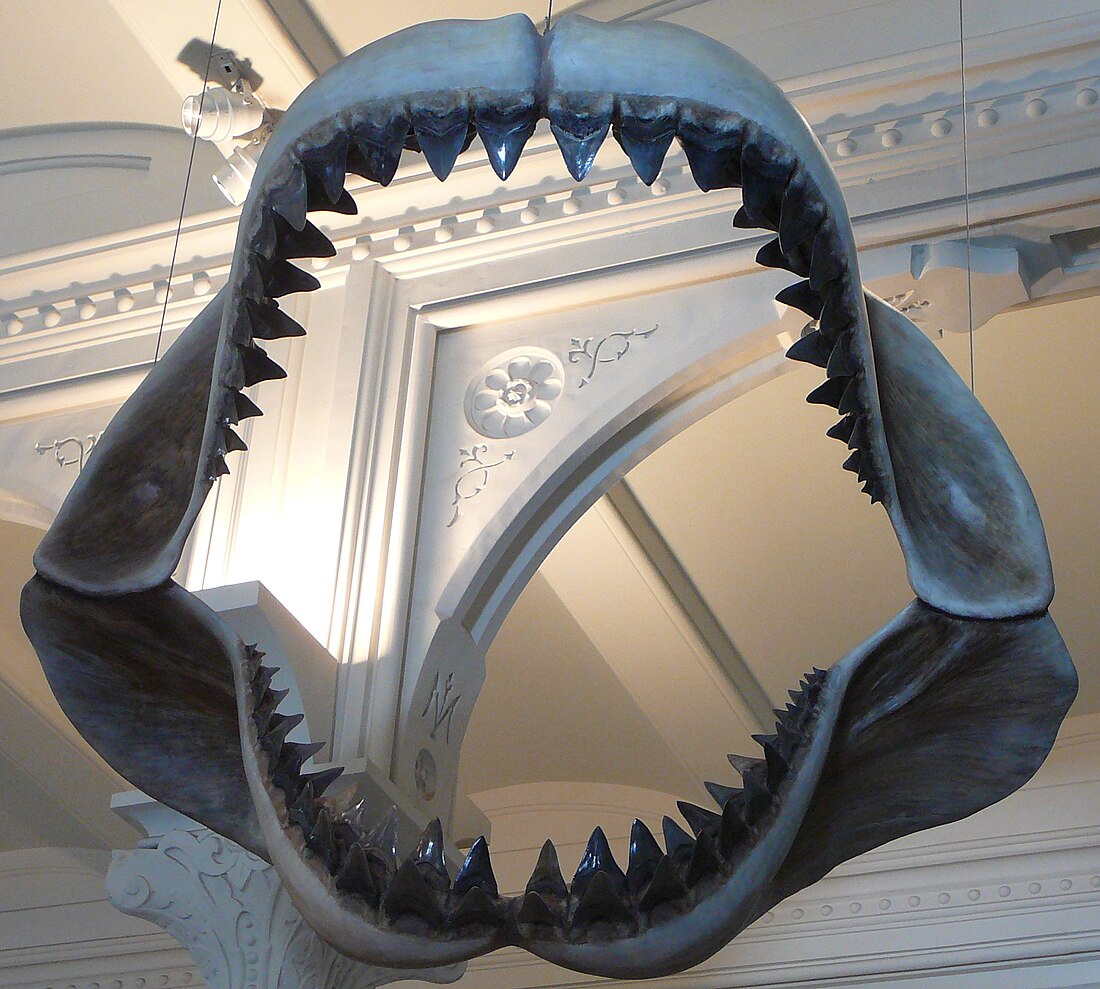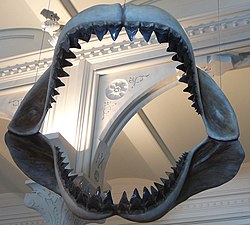Megalodon
extinct species of shark From Wikipedia, the free encyclopedia
Remove ads
Megalodon is an extinct species of shark. It was the largest shark of all time, as far as we know.


Its scientific name is Otodus megalodon (meaning "Big ear-shapped tooth"). It lived from the early Miocene to the Pliocene epochs, 23 to 3.6 million years ago (mya).
It is a member of the family Otodontidae. When it was first described, paleontologists thought it was the ancestor of the present-day great white shark (Carcharodon carcharias ). However, closer inspection distanced the 2 species.
Megalodon's teeth are among the largest ever found. They are over 18 cm (7.1 in) long. Nicolaus Steno was the first to recognize the teeth as those of a giant shark.
Paleontologists calculate that the shark was up to 20.3 m (67 ft) long, with an average length of 17 meters (56 feet). It weighed up to 48-103 metric tons.[1]
Remove ads
Classification
As is the case with most sharks, the classification of O. megalodon is under debate. The species was named Carcharodon megalodon by the French naturalist Louis Agassiz.
During this period, species within the same genus were named, such as Carcharodon productus and Carcharodon rectidens, which were synonymized as belonging to the same species a few decades later.
For a long time, Megalodon was considered an extinct species of Great White Shark, popularly called the "Giant Great White Shark" or informally the "Monster Shark."
This changed with new studies in the early 20th century. Scientists began to classify Megalodon more closely within the genus Carcharocles and as part of the Otodontid evolutionary line. Nowadays, the species can be classified in different genera, in the genus Otodus, Procarcharodon, Megaselachus, or Carcharocles. This is because Megalodon belongs to a lineage of chronospecies, which have evolved over time.
Remove ads
Paleoecology
Fossil records of O. megalodon indicate that it occurred in deep to tropical latitudes.[2] Before the formation of the Isthmus of Panama, the seas were relatively warmer.[3] This would have made it possible for Megalodon to live in all the oceans of the world.
O. megalodon lived in many marine environments, like continental shelf waters,[4] coastal upwelling,[4] swampy coastal lagoons,[4] sandy littorals,[4] and offshore deep water environments).[5] It moved from place to place.[4] Adult O. megalodon were not abundant in shallow water environments,[4] and mostly lurked offshore. O. megalodon may have moved between coastal and oceanic waters at different stages in its life.
Remove ads
Prey
Its great size,[6] high-speed swimming capability,[7] powerful jaws, and formidable killing apparatus[2][6] made Megalodon an apex predator eating a range of fauna.
Fossil evidence suggests that O. megalodon preyed on:
- Cetaceans (i.e., dolphins)[2]
- Small whales[4][8]
- Odobenocetops[9]
- Giant sea turtles[4]
- Large whales[10] (including sperm whales,[5][11] bowhead whales,[12] and rorquals[10][13])
- Pinnipeds[14]
- Porpoises[5]
- Sirenians[4][15]
When Megalodon hunted large and medium-sized whales, it would attack the bony areas, such as chest, fins, or tail. It could also kill quickly with a fatal bite to the chest. The megalodon bite is considered one of the strongest bites in the animal kingdom’s history.
Marine mammals were regular prey targets for megalodon. There have been almost no whale bones found with clear signs of large bite marks (deep gashes) made by teeth that match those of megalodon,[2][8] and few excavations have revealed megalodon teeth lying close to any remains of whales,[2] leading to speculation as to whether or not they truly lived. Fossil evidence of interactions between megalodon and pinnipeds also exist. In one interesting observation, a 127 millimetres (5.0 in) megalodon tooth was found lying very close to a bitten ear bone[16] of a sea lion.[14]
Relationships
The Megalodon is a member of the family Otodus and is not a related species of the great white shark (Carcharodon carcharias). It was theorized that Megalodon evolved this way:
- Palaeocarcharodon orientalis evolved into Otodus (Carcharocles) auriculatus
- Otodus (Carcharocles) auriculatus evolved into Otodus sokolovi
- Otodus sokolovi evolved into Otodus (Carcharocles) angustidens
- Otodus (Carcharocles) angustidens evolved into Otodus (Megaselachus) chubutensis
- Otodus (Megaselachus) chubutensis evolved into Otodus (Megaselachus) megalodon
However, this theory has been disproven because there are too many missing links in this evolutionary process. There would be an abundance of fossils (like guppies and adult sharks) that show a slow progression from the mighty megalodon to the fierce great white of the modern day.[17]
Remove ads
References
Wikiwand - on
Seamless Wikipedia browsing. On steroids.
Remove ads

